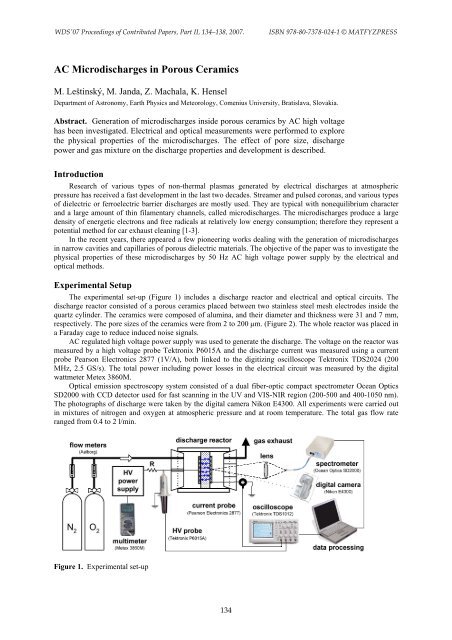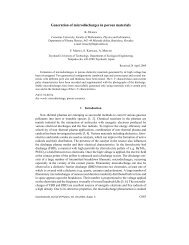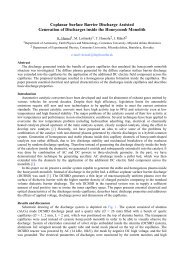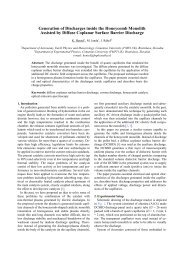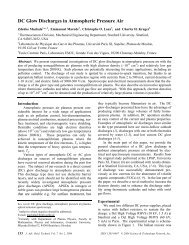Example of WDS style article: MS WORD template
Example of WDS style article: MS WORD template
Example of WDS style article: MS WORD template
- No tags were found...
You also want an ePaper? Increase the reach of your titles
YUMPU automatically turns print PDFs into web optimized ePapers that Google loves.
<strong>WDS</strong>'07 Proceedings <strong>of</strong> Contributed Papers, Part II, 134–138, 2007.ISBN 978-80-7378-024-1 © MATFYZPRESSAC Microdischarges in Porous CeramicsM. Leštinský, M. Janda, Z. Machala, K. HenselDepartment <strong>of</strong> Astronomy, Earth Physics and Meteorology, Comenius University, Bratislava, Slovakia.Abstract. Generation <strong>of</strong> microdischarges inside porous ceramics by AC high voltagehas been investigated. Electrical and optical measurements were performed to explorethe physical properties <strong>of</strong> the microdischarges. The effect <strong>of</strong> pore size, dischargepower and gas mixture on the discharge properties and development is described.IntroductionResearch <strong>of</strong> various types <strong>of</strong> non-thermal plasmas generated by electrical discharges at atmosphericpressure has received a fast development in the last two decades. Streamer and pulsed coronas, and various types<strong>of</strong> dielectric or ferroelectric barrier discharges are mostly used. They are typical with nonequilibrium characterand a large amount <strong>of</strong> thin filamentary channels, called microdischarges. The microdischarges produce a largedensity <strong>of</strong> energetic electrons and free radicals at relatively low energy consumption; therefore they represent apotential method for car exhaust cleaning [1-3].In the recent years, there appeared a few pioneering works dealing with the generation <strong>of</strong> microdischargesin narrow cavities and capillaries <strong>of</strong> porous dielectric materials. The objective <strong>of</strong> the paper was to investigate thephysical properties <strong>of</strong> these microdischarges by 50 Hz AC high voltage power supply by the electrical andoptical methods.Experimental SetupThe experimental set-up (Figure 1) includes a discharge reactor and electrical and optical circuits. Thedischarge reactor consisted <strong>of</strong> a porous ceramics placed between two stainless steel mesh electrodes inside thequartz cylinder. The ceramics were composed <strong>of</strong> alumina, and their diameter and thickness were 31 and 7 mm,respectively. The pore sizes <strong>of</strong> the ceramics were from 2 to 200 µm. (Figure 2). The whole reactor was placed ina Faraday cage to reduce induced noise signals.AC regulated high voltage power supply was used to generate the discharge. The voltage on the reactor wasmeasured by a high voltage probe Tektronix P6015A and the discharge current was measured using a currentprobe Pearson Electronics 2877 (1V/A), both linked to the digitizing oscilloscope Tektronix TDS2024 (200MHz, 2.5 GS/s). The total power including power losses in the electrical circuit was measured by the digitalwattmeter Metex 3860M.Optical emission spectroscopy system consisted <strong>of</strong> a dual fiber-optic compact spectrometer Ocean OpticsSD2000 with CCD detector used for fast scanning in the UV and VIS-NIR region (200-500 and 400-1050 nm).The photographs <strong>of</strong> discharge were taken by the digital camera Nikon E4300. All experiments were carried outin mixtures <strong>of</strong> nitrogen and oxygen at atmospheric pressure and at room temperature. The total gas flow rateranged from 0.4 to 2 l/min.Figure 1. Experimental set-up134


